TECO101 Microeconomics Principles: Market Analysis and Game Theory
VerifiedAdded on 2023/06/07
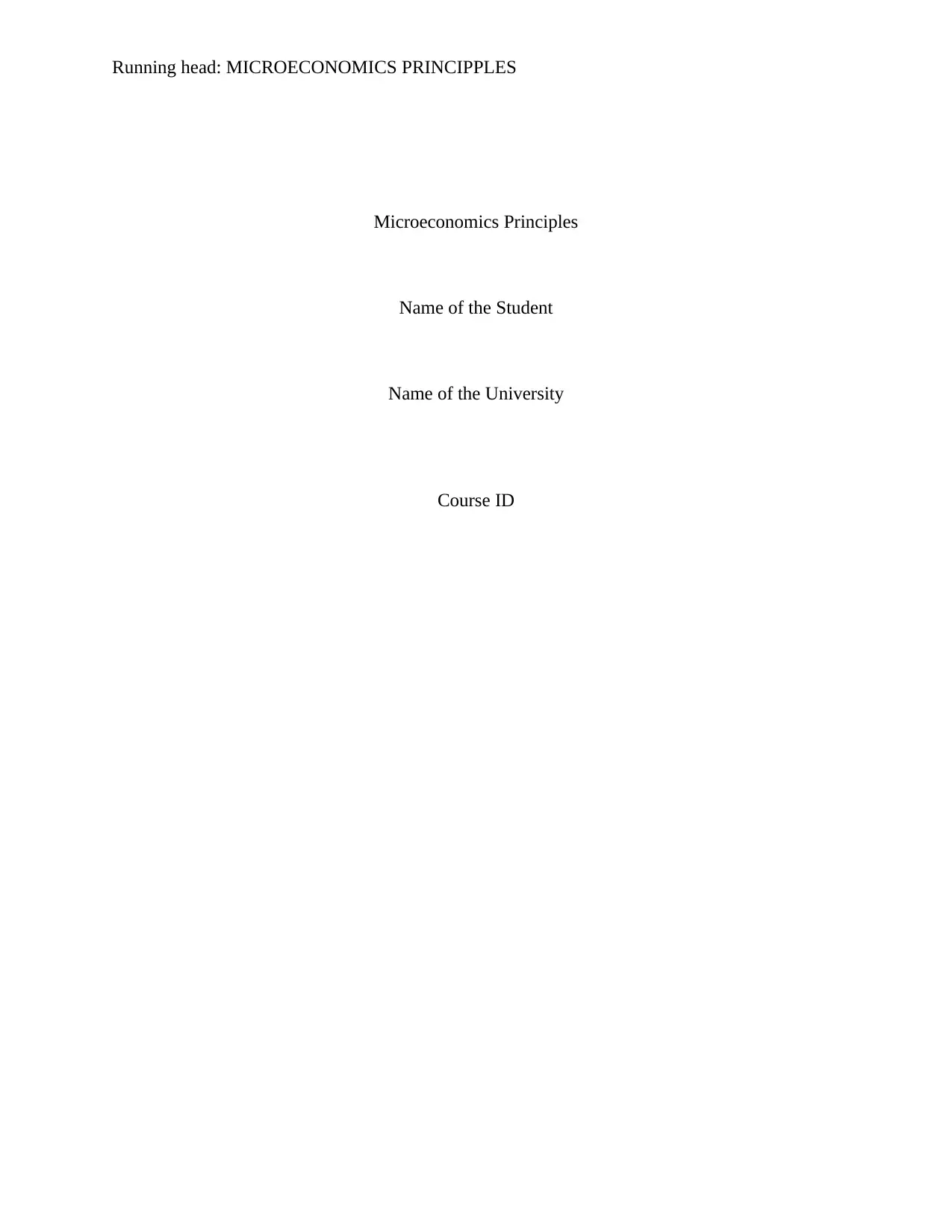
Microeconomics Principles
Name of the Student
Name of the University
Course ID
Paraphrase This Document
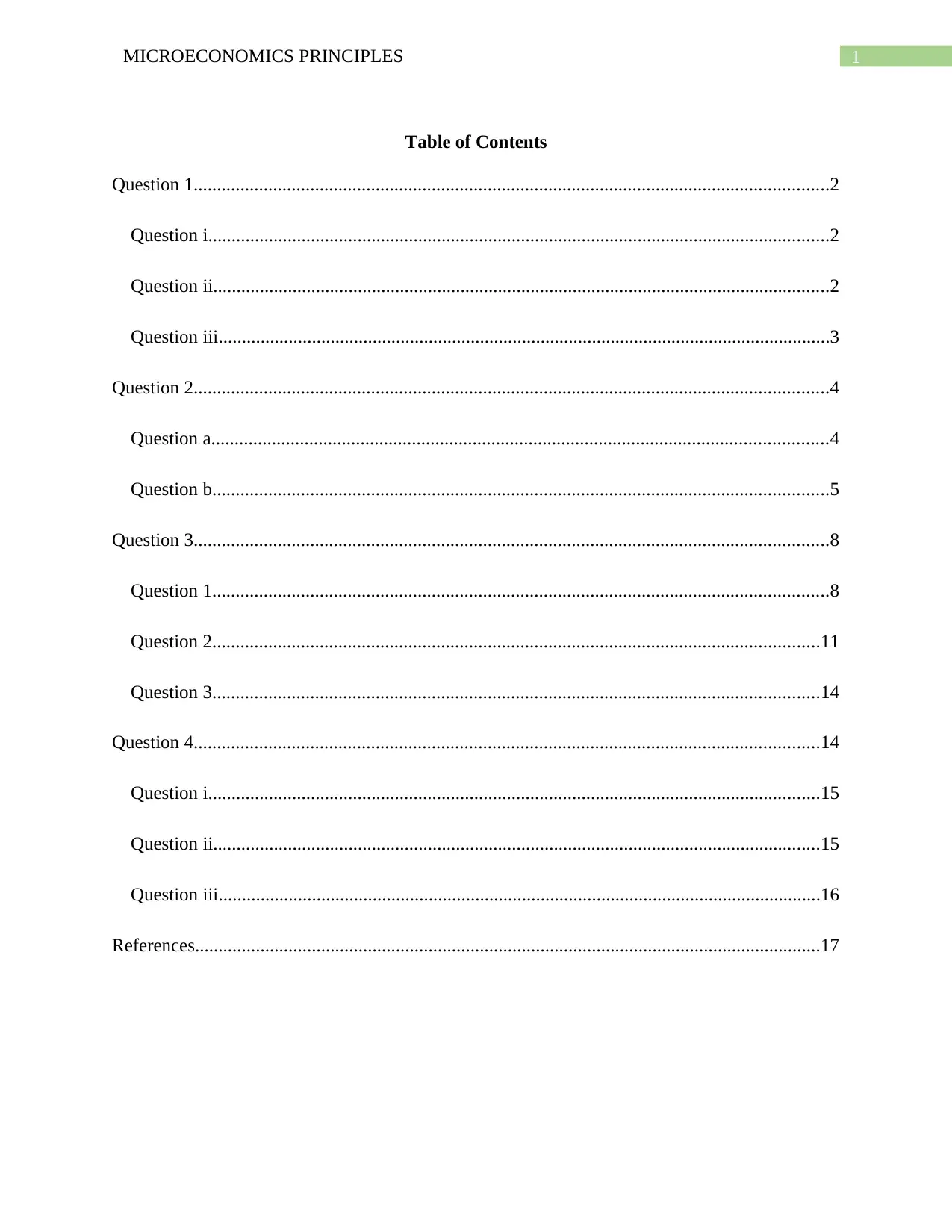
Table of Contents
Question 1........................................................................................................................................2
Question i.....................................................................................................................................2
Question ii....................................................................................................................................2
Question iii...................................................................................................................................3
Question 2........................................................................................................................................4
Question a....................................................................................................................................4
Question b....................................................................................................................................5
Question 3........................................................................................................................................8
Question 1....................................................................................................................................8
Question 2..................................................................................................................................11
Question 3..................................................................................................................................14
Question 4......................................................................................................................................14
Question i...................................................................................................................................15
Question ii..................................................................................................................................15
Question iii.................................................................................................................................16
References......................................................................................................................................17
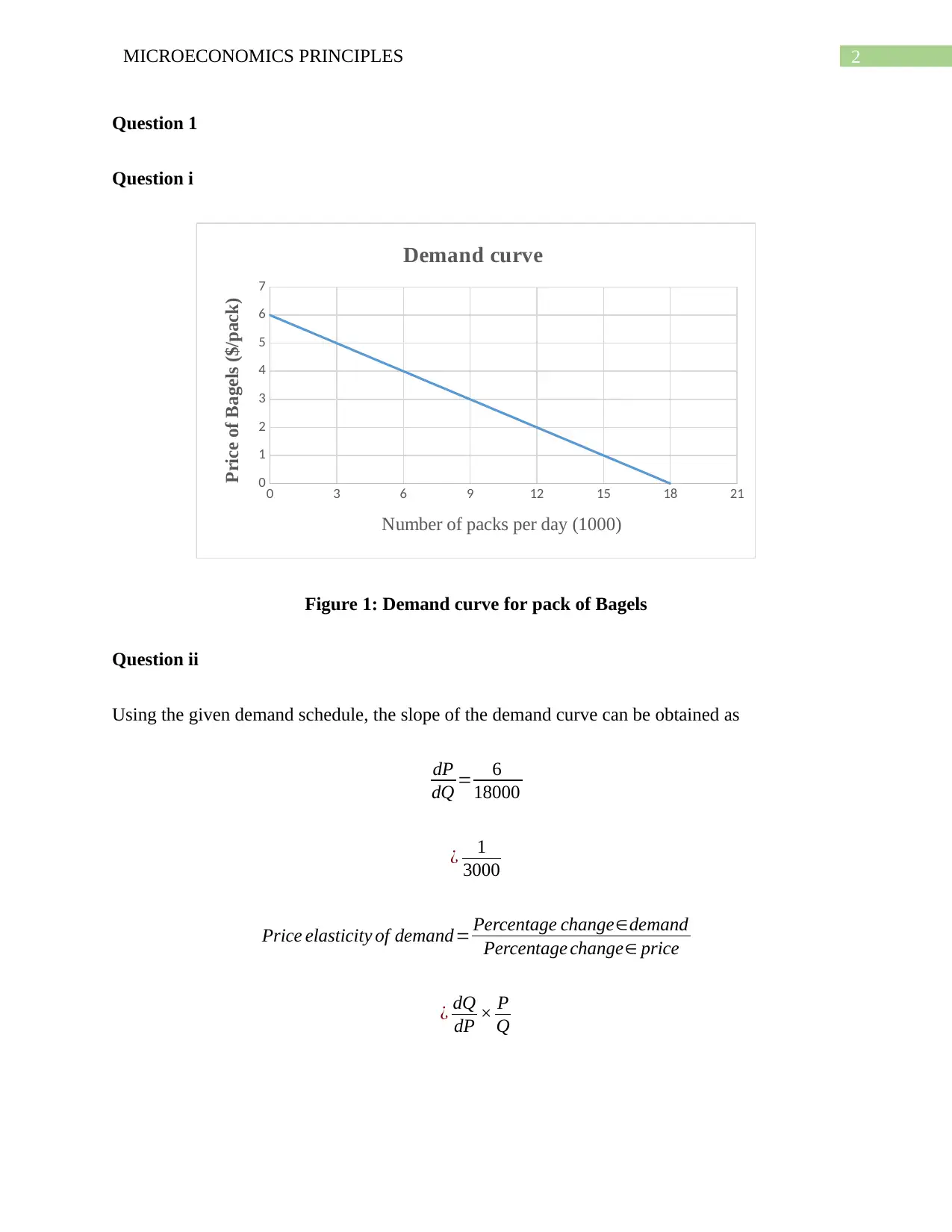
Question 1
Question i
0 3 6 9 12 15 18 21
0
1
2
3
4
5
6
7
Demand curve
Number of packs per day (1000)
Price of Bagels ($/pack)
Figure 1: Demand curve for pack of Bagels
Question ii
Using the given demand schedule, the slope of the demand curve can be obtained as
dP
dQ = 6
18000
¿ 1
3000
Price elasticity of demand= Percentage change∈demand
Percentage change∈ price
¿ dQ
dP × P
Q
⊘ This is a preview!⊘
Do you want full access?
Subscribe today to unlock all pages.

Trusted by 1+ million students worldwide
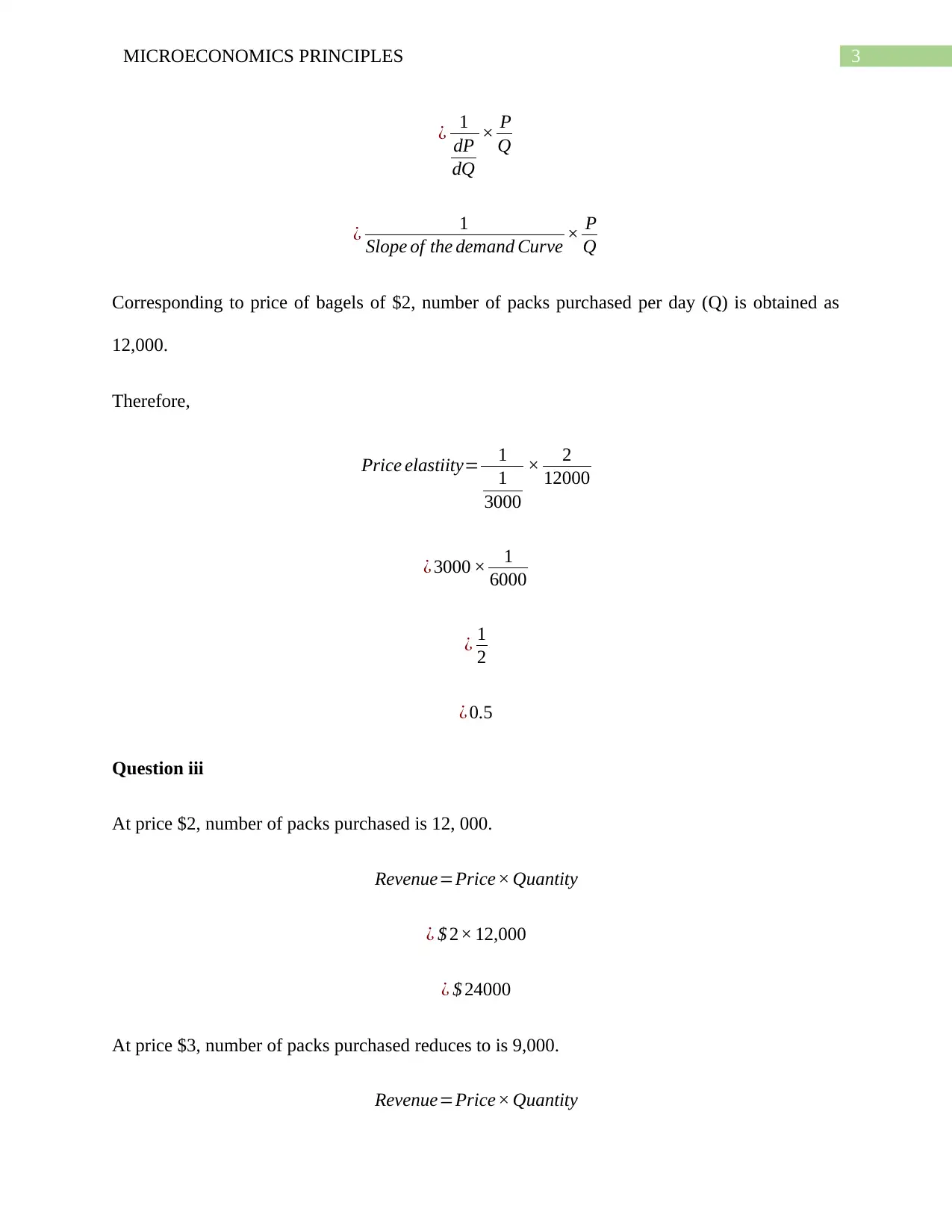
¿ 1
dP
dQ
× P
Q
¿ 1
Slope of the demand Curve × P
Q
Corresponding to price of bagels of $2, number of packs purchased per day (Q) is obtained as
12,000.
Therefore,
Price elastiity= 1
1
3000
× 2
12000
¿ 3000 × 1
6000
¿ 1
2
¿ 0.5
Question iii
At price $2, number of packs purchased is 12, 000.
Revenue=Price× Quantity
¿ $ 2× 12,000
¿ $ 24000
At price $3, number of packs purchased reduces to is 9,000.
Revenue=Price× Quantity
Paraphrase This Document

¿ $ 3 ×9000
¿ $ 27000
Therefore, an increase in price of bagels from $2 per pack to $3 per pack revenue increases from
$24,000 to $27,000.
Question 2
Question a
Profit maximizing level of output is obtained where marginal revenue intersects marginal
cost curve (Baumol and Blinder 2015).
Corresponding to a price of pizza per slice of $2.50, Quantity of pizza sold equals to 570.
Total revenue of the pizza seller is
Revenue=Price× Quantity
¿ $ 2.50 ×570
¿ $ 1425
The average total cost this level of price and output is $1.40
Total Cost = Average total cost × Quantity
¿ $ 1.40× 570
¿ $ 798
Profit=Total Revenue−Total Cost
¿ $ 1425−$ 798

¿ $ 627
Question b
i)
0 20 40 60 80 100 120
0
20
40
60
80
100
120
Demand and Marginal Cost
P MC
Quantity
Price, Cost
Figure 2: Demand and marginal cost curve
ii)
0 20 40 60 80 100 120
-40
-20
0
20
40
60
80
Marginal Revenue
Quantity
Marginal Revenue
⊘ This is a preview!⊘
Do you want full access?
Subscribe today to unlock all pages.

Trusted by 1+ million students worldwide
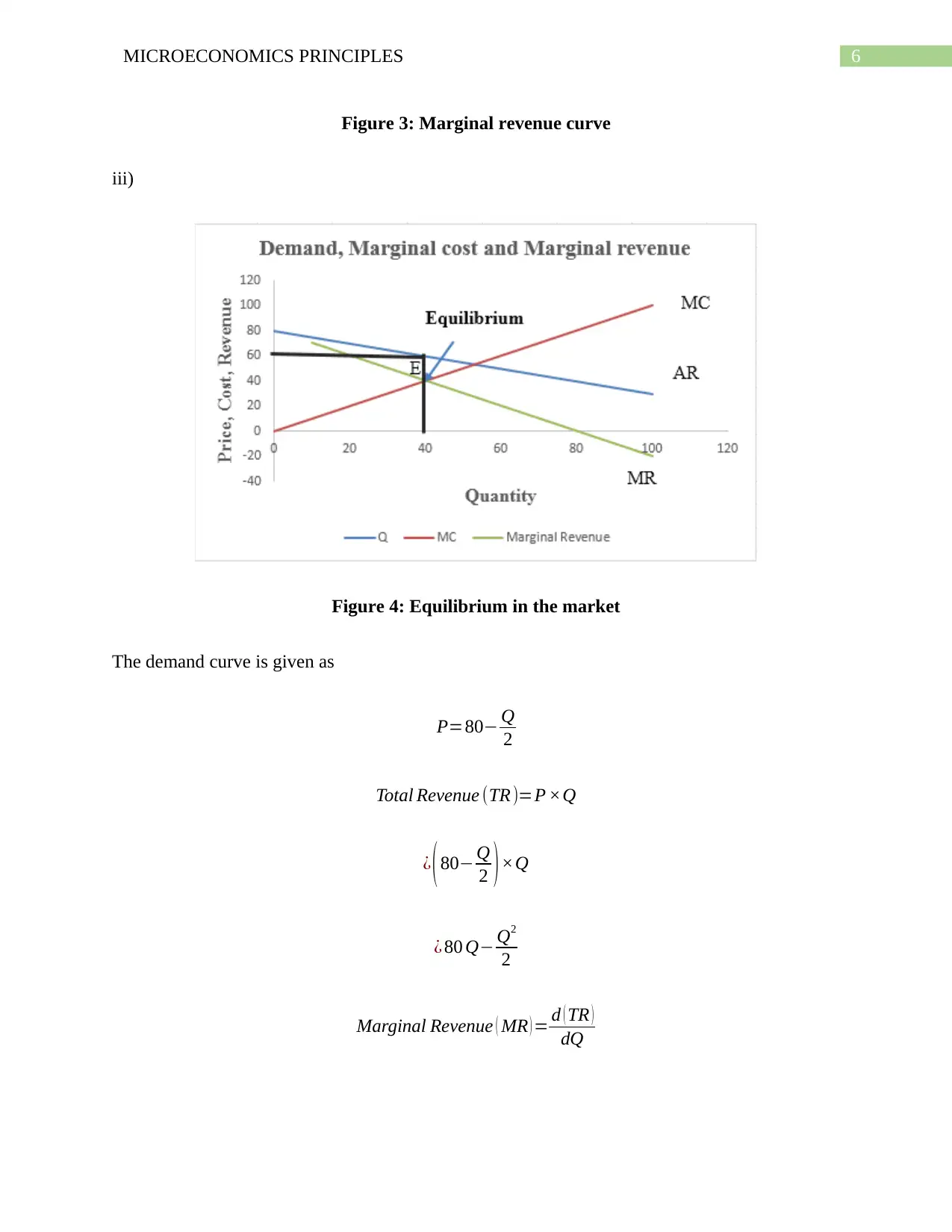
Figure 3: Marginal revenue curve
iii)
Figure 4: Equilibrium in the market
The demand curve is given as
P=80− Q
2
Total Revenue (TR)=P ×Q
¿ (80− Q
2 )×Q
¿ 80 Q− Q2
2
Marginal Revenue ( MR ) = d ( TR )
dQ
Paraphrase This Document
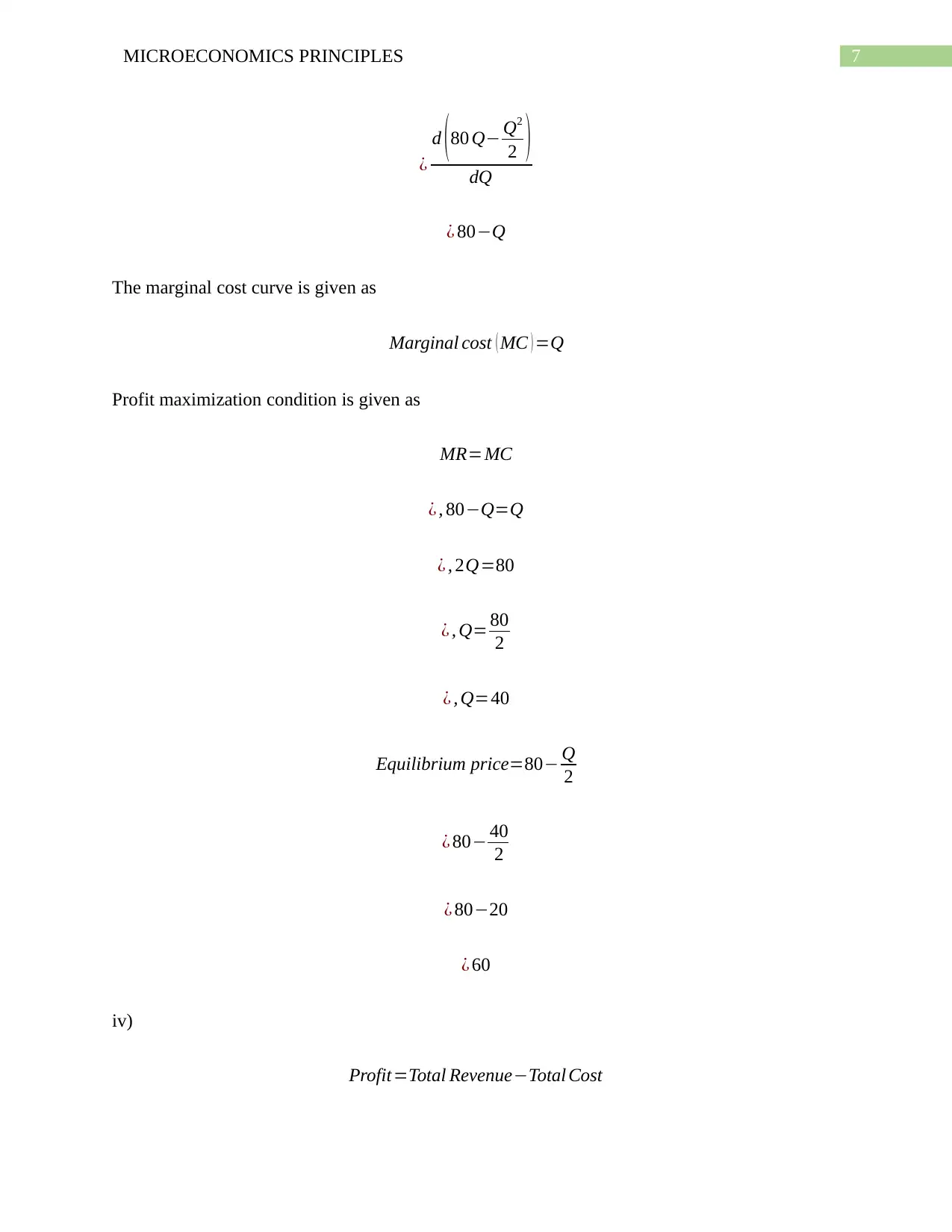
¿
d (80 Q− Q2
2 )
dQ
¿ 80−Q
The marginal cost curve is given as
Marginal cost ( MC ) =Q
Profit maximization condition is given as
MR=MC
¿ , 80−Q=Q
¿ , 2Q=80
¿ , Q= 80
2
¿ , Q=40
Equilibrium price=80− Q
2
¿ 80− 40
2
¿ 80−20
¿ 60
iv)
Profit=Total Revenue−Total Cost
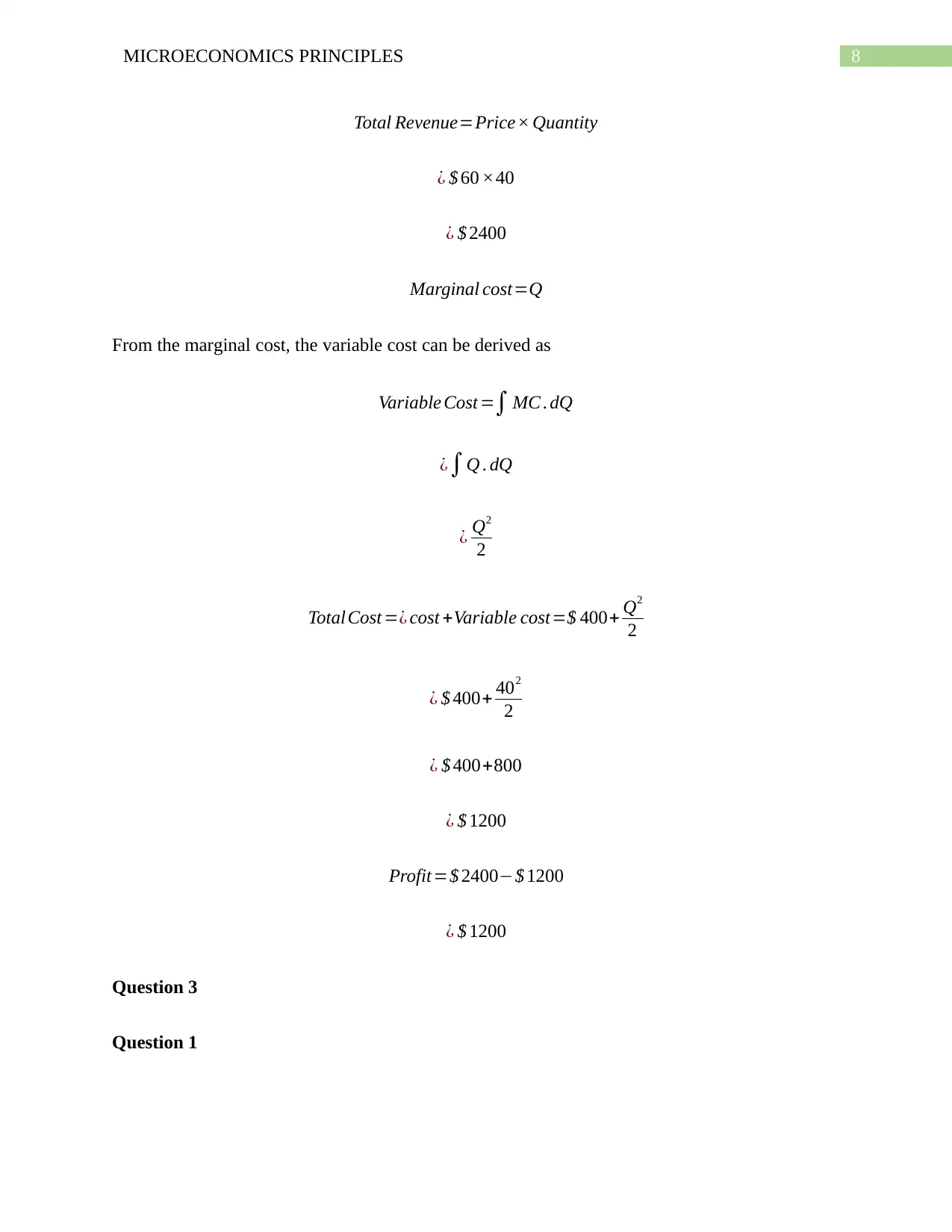
Total Revenue=Price× Quantity
¿ $ 60 ×40
¿ $ 2400
Marginal cost=Q
From the marginal cost, the variable cost can be derived as
Variable Cost =∫ MC . dQ
¿∫Q . dQ
¿ Q2
2
Total Cost =¿ cost +Variable cost=$ 400+ Q2
2
¿ $ 400+ 402
2
¿ $ 400+800
¿ $ 1200
Profit=$ 2400−$ 1200
¿ $ 1200
Question 3
Question 1
⊘ This is a preview!⊘
Do you want full access?
Subscribe today to unlock all pages.

Trusted by 1+ million students worldwide

Figure 5: Free market equilibrium and economic surplus
Weekly demand curve is given as
P=8−Q
Weekly supply is given as
P=2+Q
Equilibrium in the market is obtained at the point where
Demand=Supply
¿ , 8−Q=2+Q
¿ , 2Q=6
¿ , Q= 6
2
¿ , Q¿=3
Paraphrase This Document
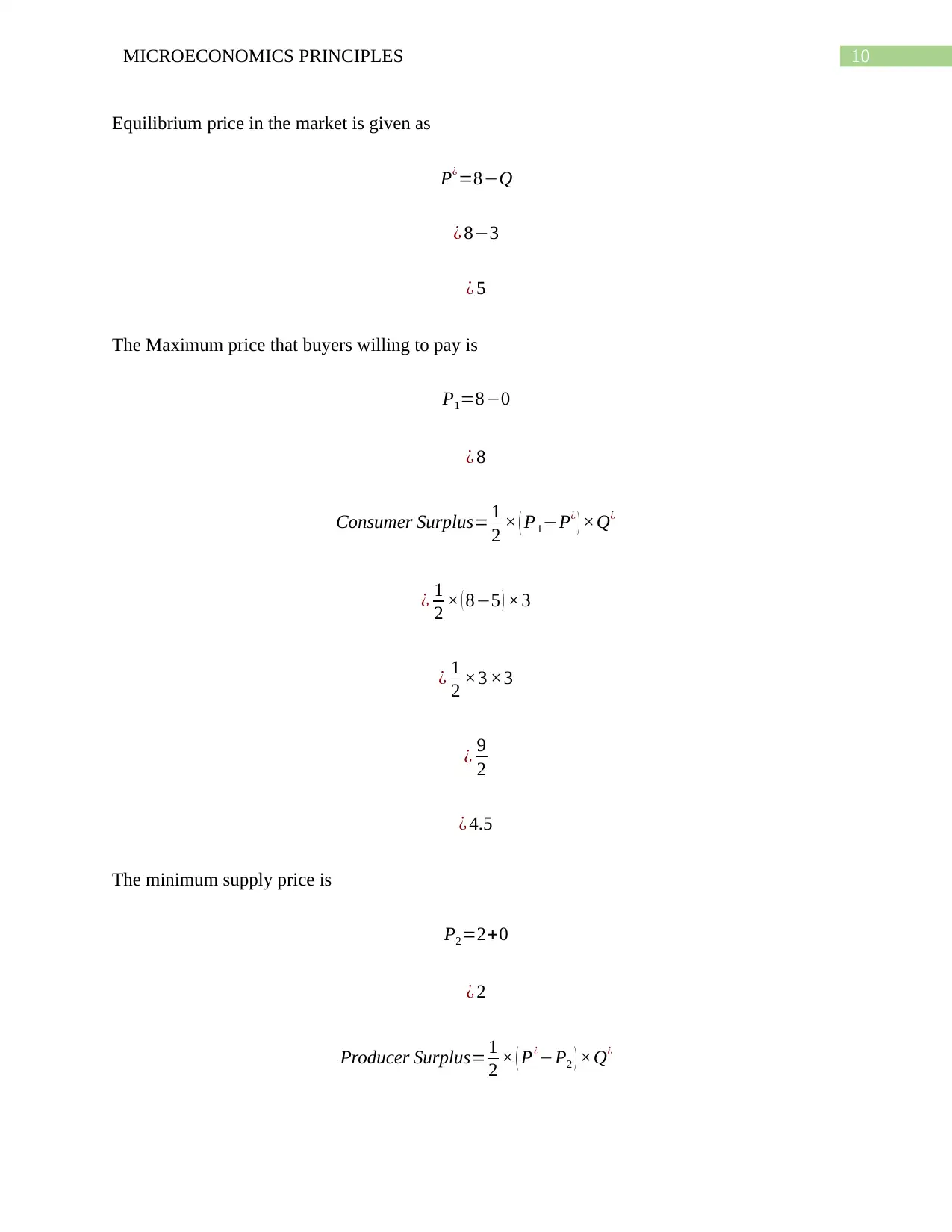
Equilibrium price in the market is given as
P¿=8−Q
¿ 8−3
¿ 5
The Maximum price that buyers willing to pay is
P1=8−0
¿ 8
Consumer Surplus= 1
2 × ( P1−P¿
) ×Q¿
¿ 1
2 × ( 8−5 ) ×3
¿ 1
2 ×3 ×3
¿ 9
2
¿ 4.5
The minimum supply price is
P2=2+0
¿ 2
Producer Surplus= 1
2 × ( P¿−P2 ) ×Q¿

¿ 1
2 × ( 5−2 ) × 3
¿ 1
2 ×3 ×3
¿ 9
2
¿ 4.5
Weekly economic surplus is the sum of consumer and producer surplus.
Economic Surplus=Consumer surplus+ Producer Surplus
¿ 4.5+ 4.5
¿ 9
Question 2
Figure 6: Change in surplus after tax
⊘ This is a preview!⊘
Do you want full access?
Subscribe today to unlock all pages.

Trusted by 1+ million students worldwide
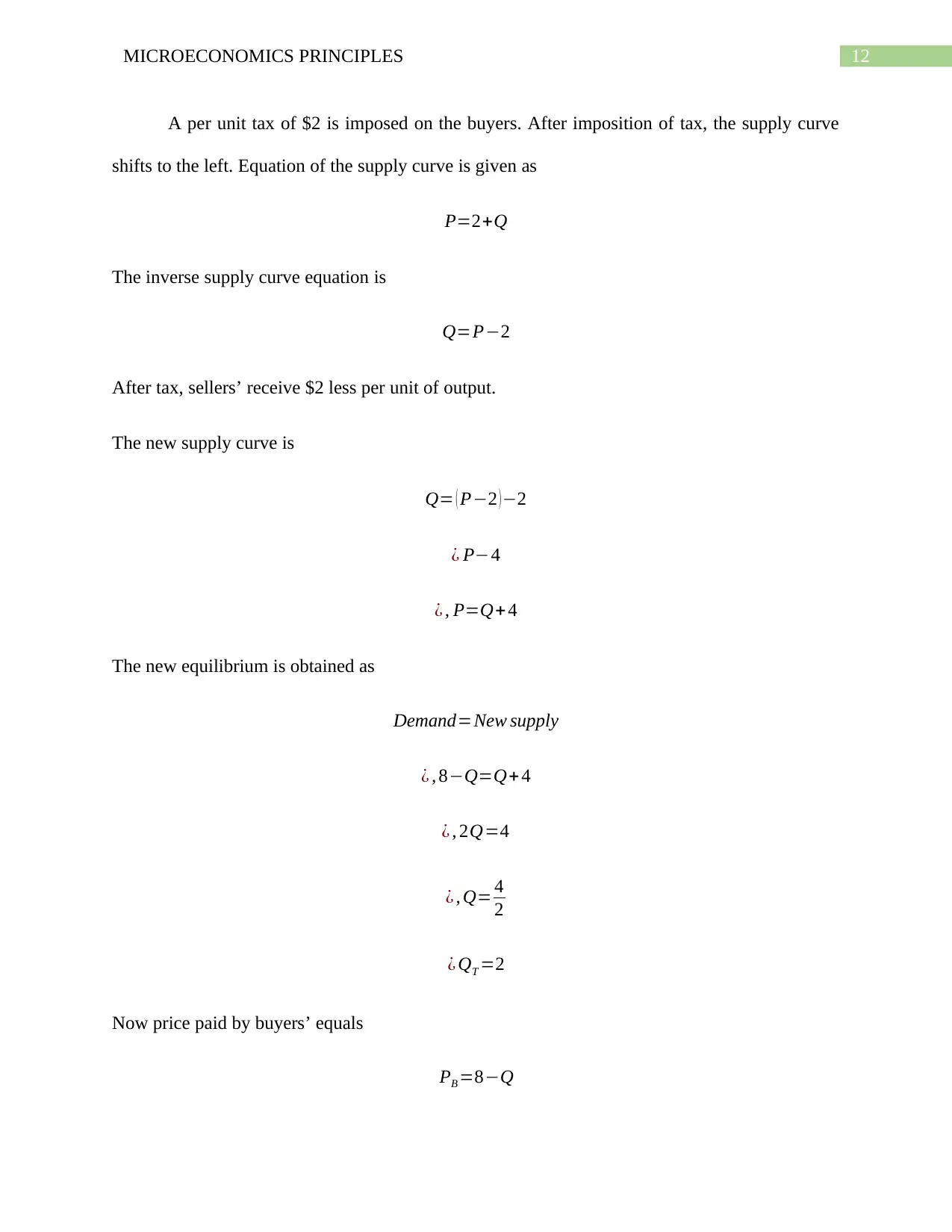
A per unit tax of $2 is imposed on the buyers. After imposition of tax, the supply curve
shifts to the left. Equation of the supply curve is given as
P=2+Q
The inverse supply curve equation is
Q=P−2
After tax, sellers’ receive $2 less per unit of output.
The new supply curve is
Q= ( P−2 )−2
¿ P−4
¿ , P=Q+ 4
The new equilibrium is obtained as
Demand=New supply
¿ , 8−Q=Q+ 4
¿ , 2Q=4
¿ , Q= 4
2
¿ QT =2
Now price paid by buyers’ equals
PB =8−Q
Paraphrase This Document
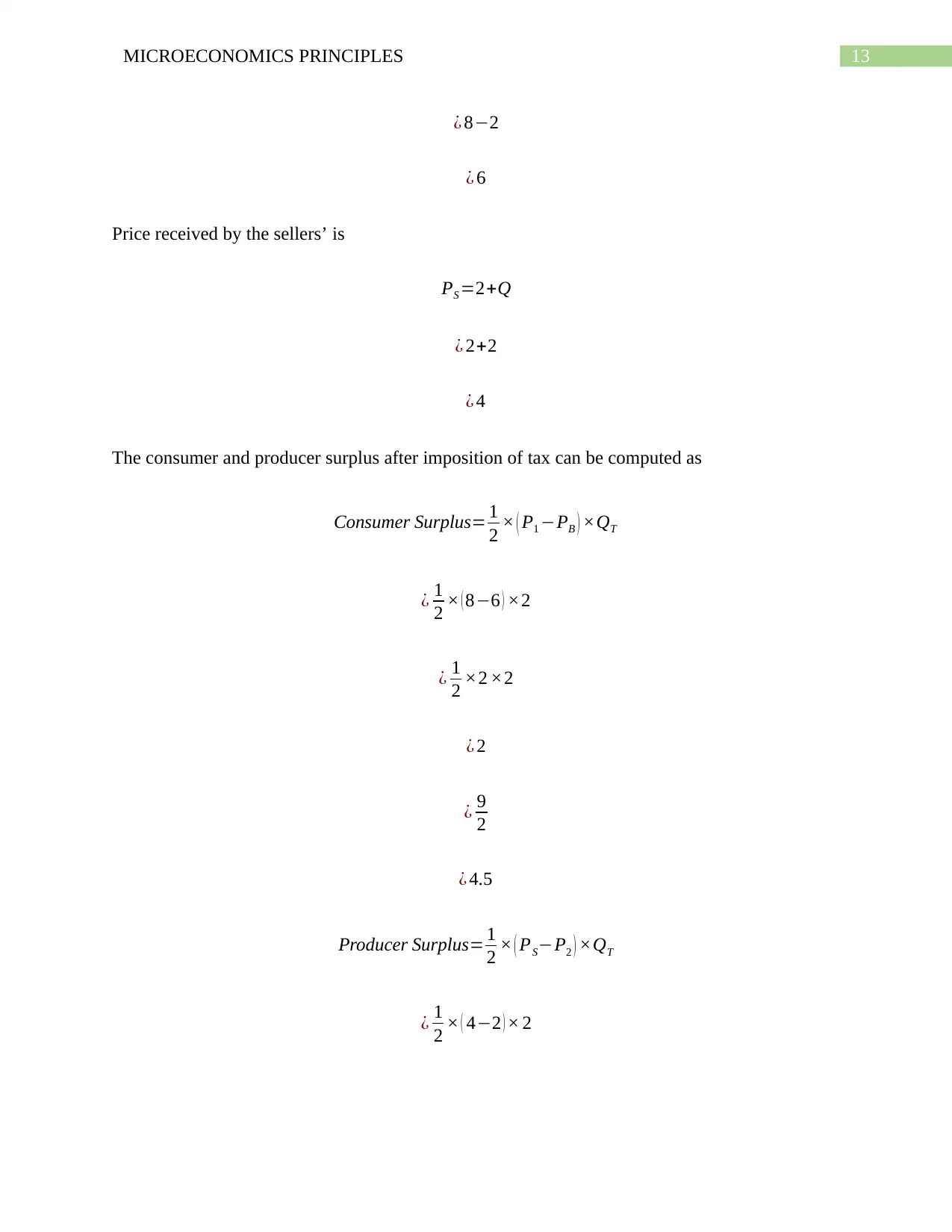
¿ 8−2
¿ 6
Price received by the sellers’ is
PS =2+Q
¿ 2+2
¿ 4
The consumer and producer surplus after imposition of tax can be computed as
Consumer Surplus= 1
2 × ( P1 −PB ) ×QT
¿ 1
2 × ( 8−6 ) ×2
¿ 1
2 ×2 ×2
¿ 2
¿ 9
2
¿ 4.5
Producer Surplus= 1
2 × ( PS−P2 ) ×QT
¿ 1
2 × ( 4−2 ) × 2
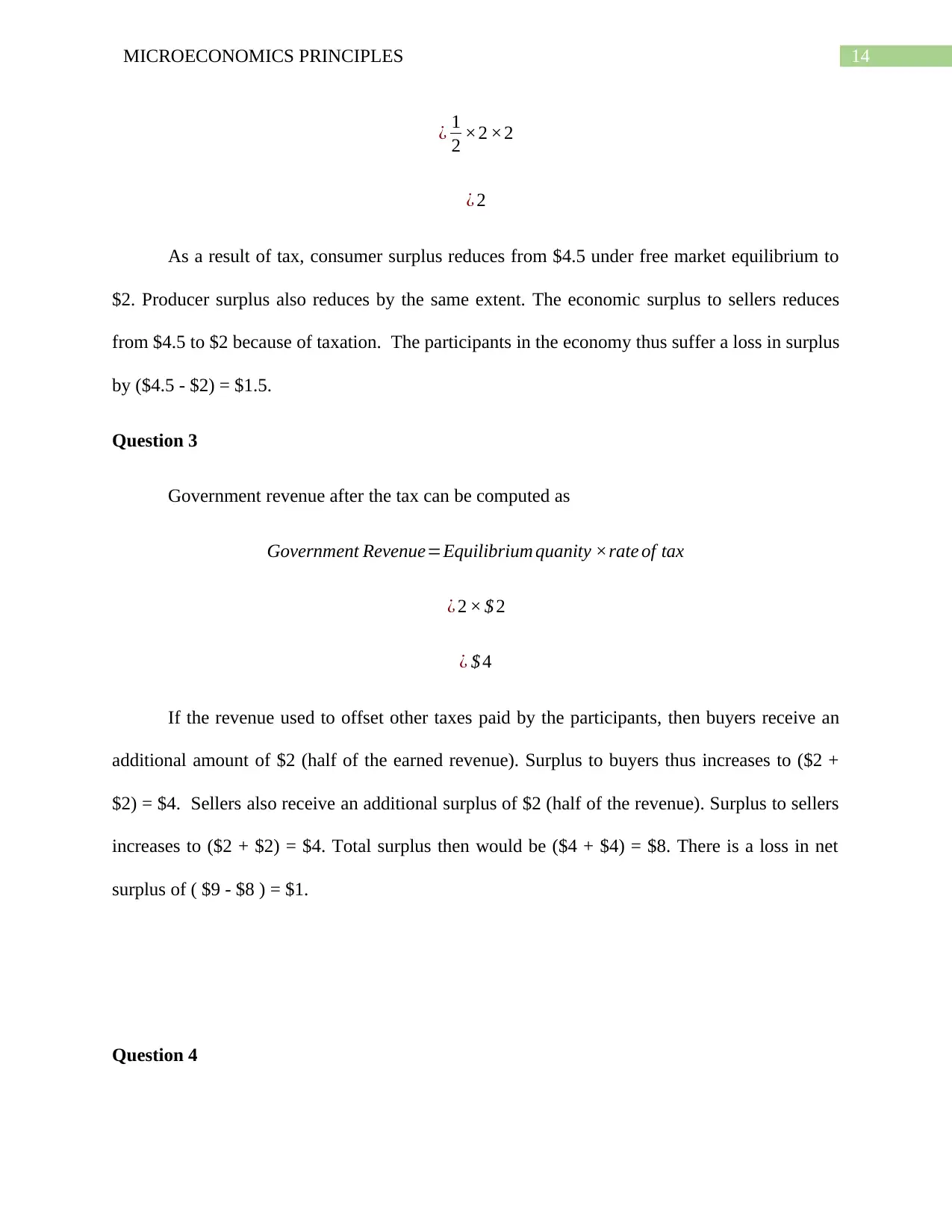
¿ 1
2 ×2 ×2
¿ 2
As a result of tax, consumer surplus reduces from $4.5 under free market equilibrium to
$2. Producer surplus also reduces by the same extent. The economic surplus to sellers reduces
from $4.5 to $2 because of taxation. The participants in the economy thus suffer a loss in surplus
by ($4.5 - $2) = $1.5.
Question 3
Government revenue after the tax can be computed as
Government Revenue=Equilibrium quanity ×rate of tax
¿ 2 × $ 2
¿ $ 4
If the revenue used to offset other taxes paid by the participants, then buyers receive an
additional amount of $2 (half of the earned revenue). Surplus to buyers thus increases to ($2 +
$2) = $4. Sellers also receive an additional surplus of $2 (half of the revenue). Surplus to sellers
increases to ($2 + $2) = $4. Total surplus then would be ($4 + $4) = $8. There is a loss in net
surplus of ( $9 - $8 ) = $1.
Question 4
⊘ This is a preview!⊘
Do you want full access?
Subscribe today to unlock all pages.

Trusted by 1+ million students worldwide
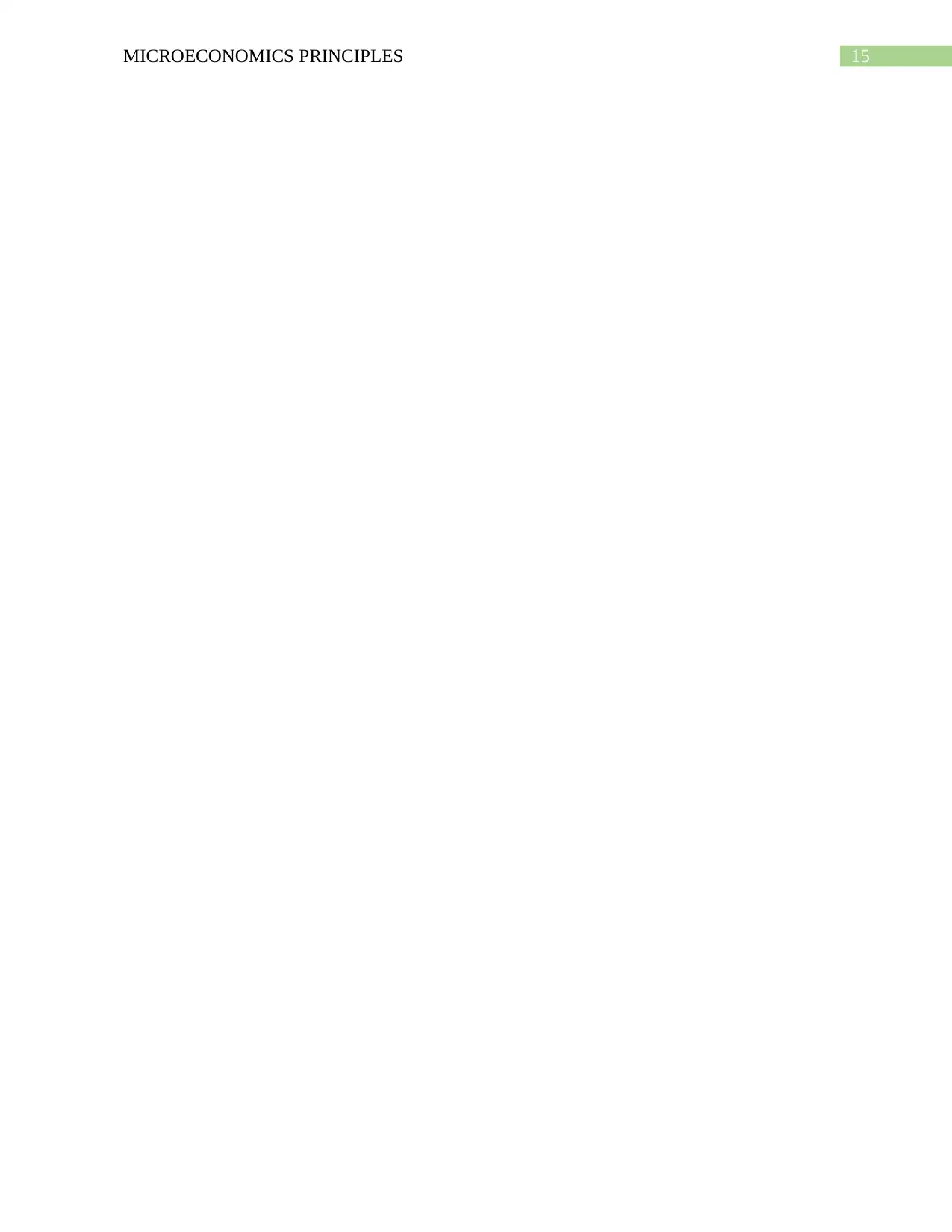
Paraphrase This Document
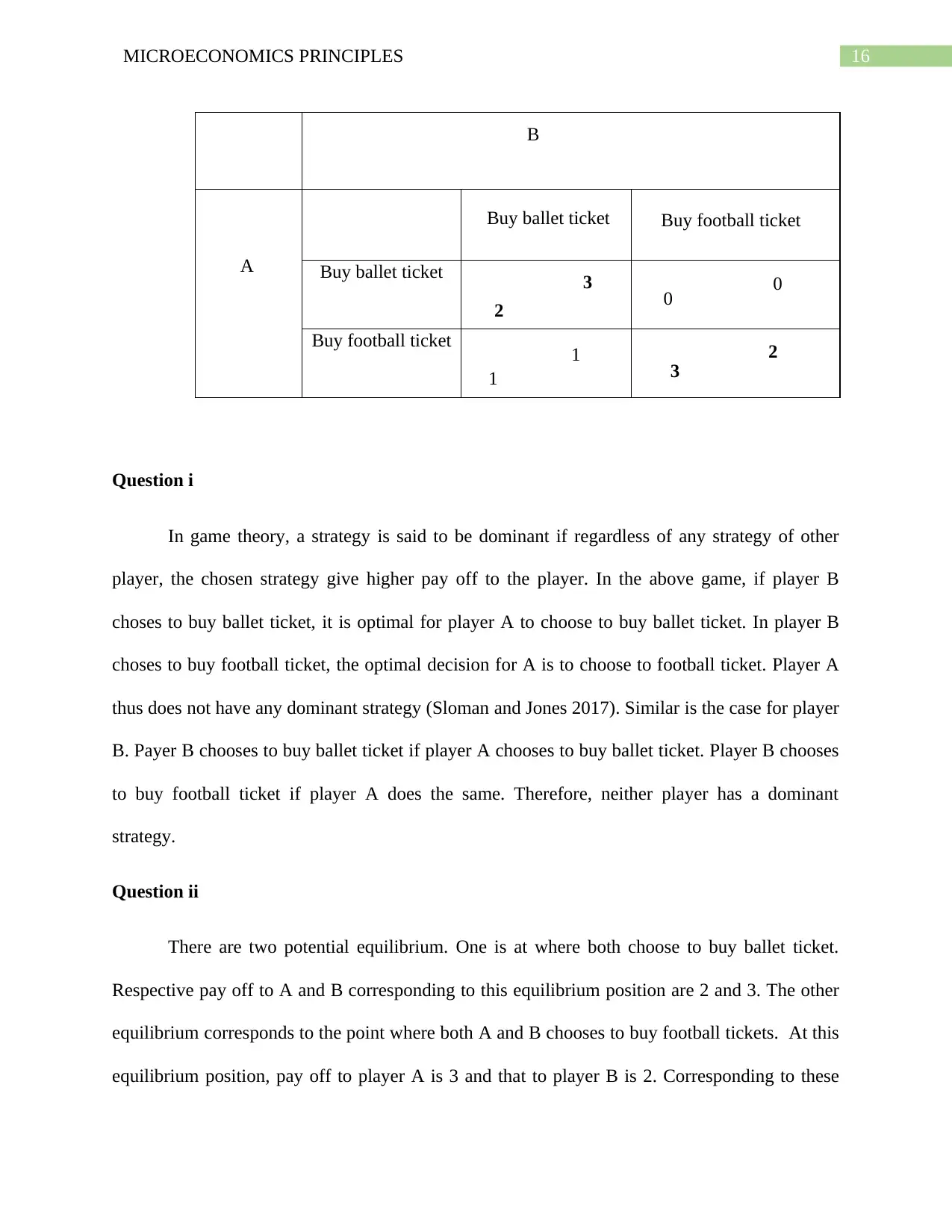
Buy ballet ticket
Buy football ticket
Question i
In game theory, a strategy is said to be dominant if regardless of any strategy of other
player, the chosen strategy give higher pay off to the player. In the above game, if player B
choses to buy ballet ticket, it is optimal for player A to choose to buy ballet ticket. In player B
choses to buy football ticket, the optimal decision for A is to choose to football ticket. Player A
thus does not have any dominant strategy (Sloman and Jones 2017). Similar is the case for player
B. Payer B chooses to buy ballet ticket if player A chooses to buy ballet ticket. Player B chooses
to buy football ticket if player A does the same. Therefore, neither player has a dominant
strategy.
Question ii
There are two potential equilibrium. One is at where both choose to buy ballet ticket.
Respective pay off to A and B corresponding to this equilibrium position are 2 and 3. The other
equilibrium corresponds to the point where both A and B chooses to buy football tickets. At this
equilibrium position, pay off to player A is 3 and that to player B is 2. Corresponding to these
B
A
Buy ballet ticket Buy football ticket
3
2
0
0
1
1
2
3
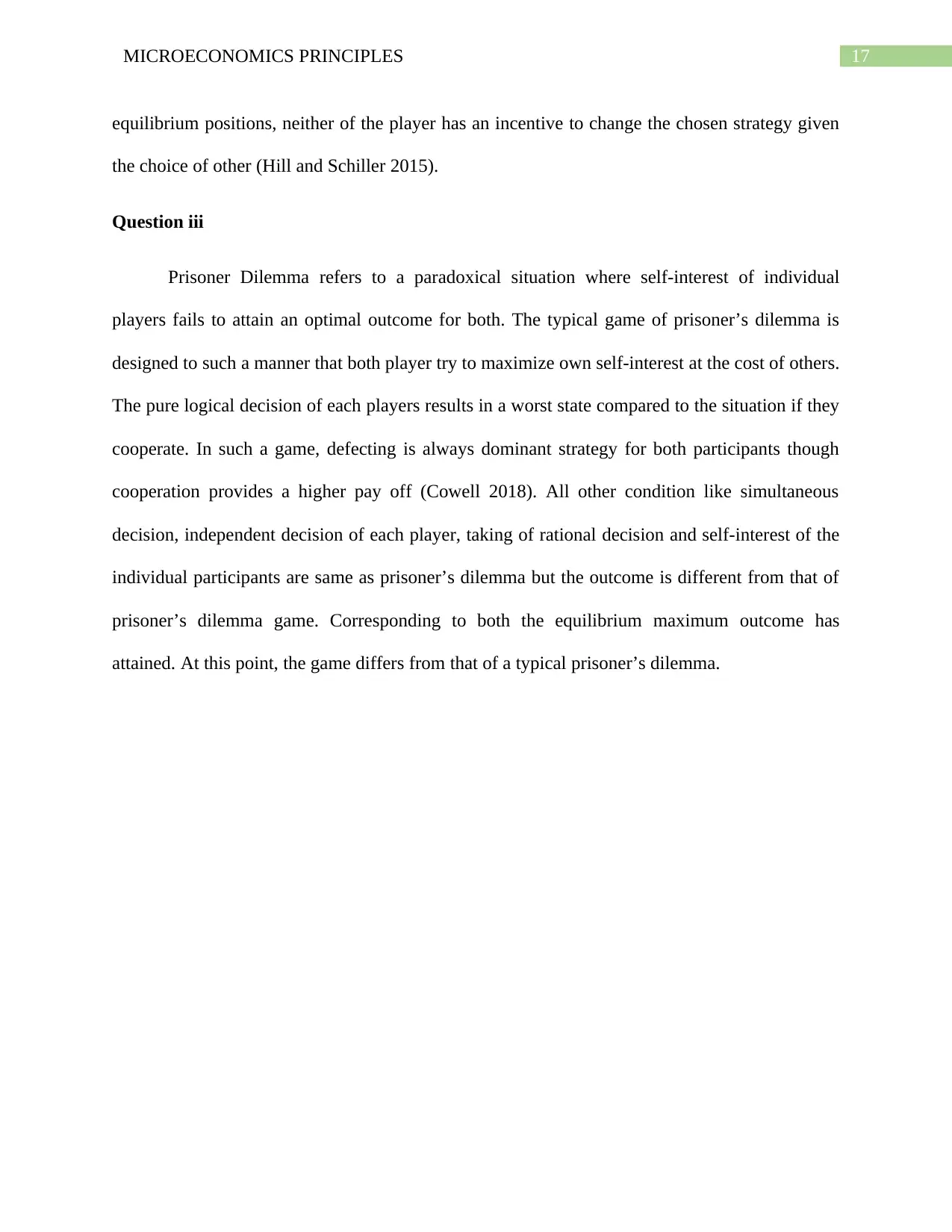
equilibrium positions, neither of the player has an incentive to change the chosen strategy given
the choice of other (Hill and Schiller 2015).
Question iii
Prisoner Dilemma refers to a paradoxical situation where self-interest of individual
players fails to attain an optimal outcome for both. The typical game of prisoner’s dilemma is
designed to such a manner that both player try to maximize own self-interest at the cost of others.
The pure logical decision of each players results in a worst state compared to the situation if they
cooperate. In such a game, defecting is always dominant strategy for both participants though
cooperation provides a higher pay off (Cowell 2018). All other condition like simultaneous
decision, independent decision of each player, taking of rational decision and self-interest of the
individual participants are same as prisoner’s dilemma but the outcome is different from that of
prisoner’s dilemma game. Corresponding to both the equilibrium maximum outcome has
attained. At this point, the game differs from that of a typical prisoner’s dilemma.
⊘ This is a preview!⊘
Do you want full access?
Subscribe today to unlock all pages.

Trusted by 1+ million students worldwide

References
Baumol, W.J. and Blinder, A.S., 2015. Microeconomics: Principles and policy. Nelson
Education.
Cowell, F. (2018). Microeconomics: principles and analysis. Oxford University Press.
Hill, C. and Schiller, B., 2015. The Micro Economy Today. McGraw-Hill Higher Education.
Sloman, J. and Jones, E., 2017. Essential Economics for Business. Pearson.
Related Documents
Your All-in-One AI-Powered Toolkit for Academic Success.
+13062052269
info@desklib.com
Available 24*7 on WhatsApp / Email
![[object Object]](/_next/static/media/star-bottom.7253800d.svg)
© 2024 | Zucol Services PVT LTD | All rights reserved.





